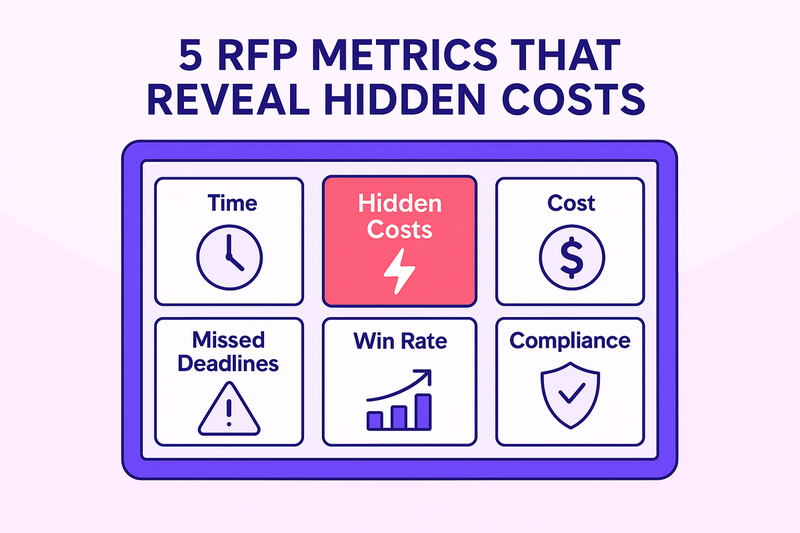5 RFP Metrics That Reveal Hidden Costs
June 24, 2025
By
Evie Secilmis

5 RFP Metrics That Reveal Hidden Inefficiencies (and How to Fix Them)
You might think your RFP process is “fine.” After all, deals are still getting done, proposals are still being submitted, and the team is making it work. But here’s the reality: if you’re not measuring your RFP process, you’re almost certainly leaking time, burning out your Sales Engineers (SEs), and missing out on faster closes.
RFPs are one of the most resource-intensive parts of the presales cycle. They touch multiple teams, require technical and legal sign-off, and often come in at the worst possible moment — right when your team is juggling other deals. Without tracking the right metrics, inefficiency creeps in silently. Reviews drag on, the same answers get rewritten again and again, and valuable SE time disappears into repetitive admin work instead of building relationships.
The good news? Once you start measuring, you uncover exactly where the bottlenecks are — and you can fix them. Here are five overlooked RFP metrics that expose where you’re losing efficiency, plus examples of what leading teams using Iris have done to turn those weaknesses into wins.
1. Review Cycles Per RFP
What it reveals: How many internal handoffs it takes to finalize a response.
Every time an RFP bounces from Sales → Legal → Security → back to Sales, you add another layer of risk: lost context, version control issues, or missed deadlines. Long review cycles stall deals and wear down your team’s momentum.
Most companies underestimate how much this costs them. Each round of review not only slows submission but also ties up SEs and SMEs who could be spending that time on demos or prospecting.
With Iris: Teams reduced review cycles from an average of 4.2 to just 1.8. That means proposals are finalized in half the time, with fewer back-and-forth loops. The result? Faster submissions and less “babysitting” from SEs to keep things moving.
2. SE & SME Time on RFPs
What it reveals: How much of your most valuable time is being sunk into repetitive work.
This is the hidden cost of RFPs that rarely shows up in budgets but always shows up in burnout. Sales Engineers and subject matter experts are hired for their deep expertise and ability to build trust with prospects. But in many organizations, they spend entire weeks buried in questionnaires instead of selling.
When SEs are spending 40–50% of their time on RFPs, something is broken. It means fewer demos, less coaching for reps, slower response times to customers, and SEs working nights and weekends just to keep up.
With Iris: SE time spent on RFPs dropped from 50% to just 12%, and SME involvement was reduced by 67%. That’s a massive lift. It translates to more time spent on revenue-driving activities — and, importantly, actual time off without guilt.
3. Answer Reuse Rate
What it reveals: Whether your past work is working for you.
If your team is rewriting the same security or compliance answer week after week, you don’t have a content problem — you have a process problem. Smart teams treat past RFPs as an asset, not a one-and-done deliverable.
Answer reuse is one of the fastest ways to scale. By pulling from a clean, verified content library, teams can respond faster, reduce errors, and avoid the dreaded “who owns this answer?” chaos that slows everything down.
With Iris: Teams saw knowledge reuse increase by 312%. That’s not just about speed; it’s about confidence. Everyone knows they’re working from trusted, up-to-date answers, and no one has to waste time reinventing the wheel.
4. Compliance and Accuracy Metrics
What it reveals: Whether your answers are trusted — by Legal, by Security, and ultimately by your buyers.
Inconsistent answers across RFPs can be a deal killer. If one questionnaire says you encrypt data at rest and another says you don’t, your credibility takes a hit. In regulated industries like healthcare and finance, inconsistent or inaccurate answers can even create legal and compliance risk.
Tracking compliance and accuracy metrics ensures that your content is not only fast but also trustworthy. It reduces the time Legal spends double-checking, and it builds buyer confidence that your team is reliable.
With Iris: Technical accuracy improved by 34% and compliance scores increased by 41%. Better answers mean fewer legal bottlenecks, faster approvals, and more deals moving forward without unnecessary friction.
5. Completion Rate
What it reveals: How many RFPs your team starts… but doesn’t finish.
This is the ultimate hidden cost. Every unsubmitted RFP represents not just a lost deal but also wasted hours of work. And it happens more often than most teams realize. Industry research shows that 20% of RFPs are started but never submitted.
When your team is stretched thin, they’re forced to triage. Some RFPs slip through the cracks simply because there aren’t enough hours in the day. That’s revenue left on the table before the opportunity even has a chance.
With Iris: Teams saw a 4x pipeline increase without adding headcount, simply because they stopped abandoning RFPs midstream. With automation handling the heavy lift, every opportunity gets a fair shot.
How to Start Measuring These Metrics
You don’t need a full-scale audit to get started. Just pick your last five RFPs and ask yourself:
- How many people were pulled in?
- How many rounds did it take to finalize?
- How much content was reused?
- Did we submit on time?
- What did it cost us in hours, not just effort?
Even a quick analysis of recent projects will highlight where the biggest leaks are. Once you see the cost clearly, it becomes obvious what to fix.
Final Thoughts
Sustainable efficiency doesn’t come from asking SEs to work harder. It comes from measuring the right metrics, automating the repeatable work, and freeing your team to focus on what matters most: building trust, running demos, and winning business.
TL;DR: Track what matters. Win more. Burn out less. Your SEs shouldn’t have to choose between vacation and velocity. Start measuring smarter, automate the parts that slow you down, and give your team the confidence to log off without the backlog.
Share this post
Link copied!




















